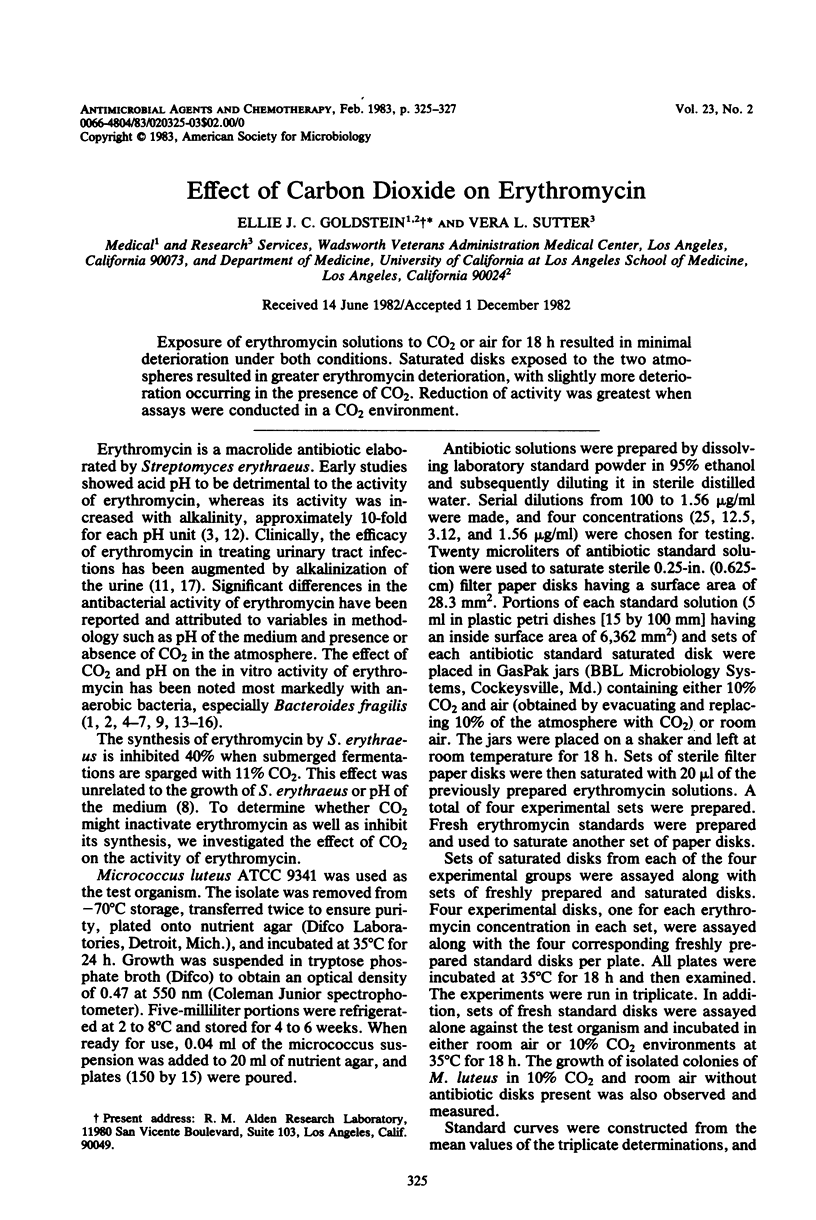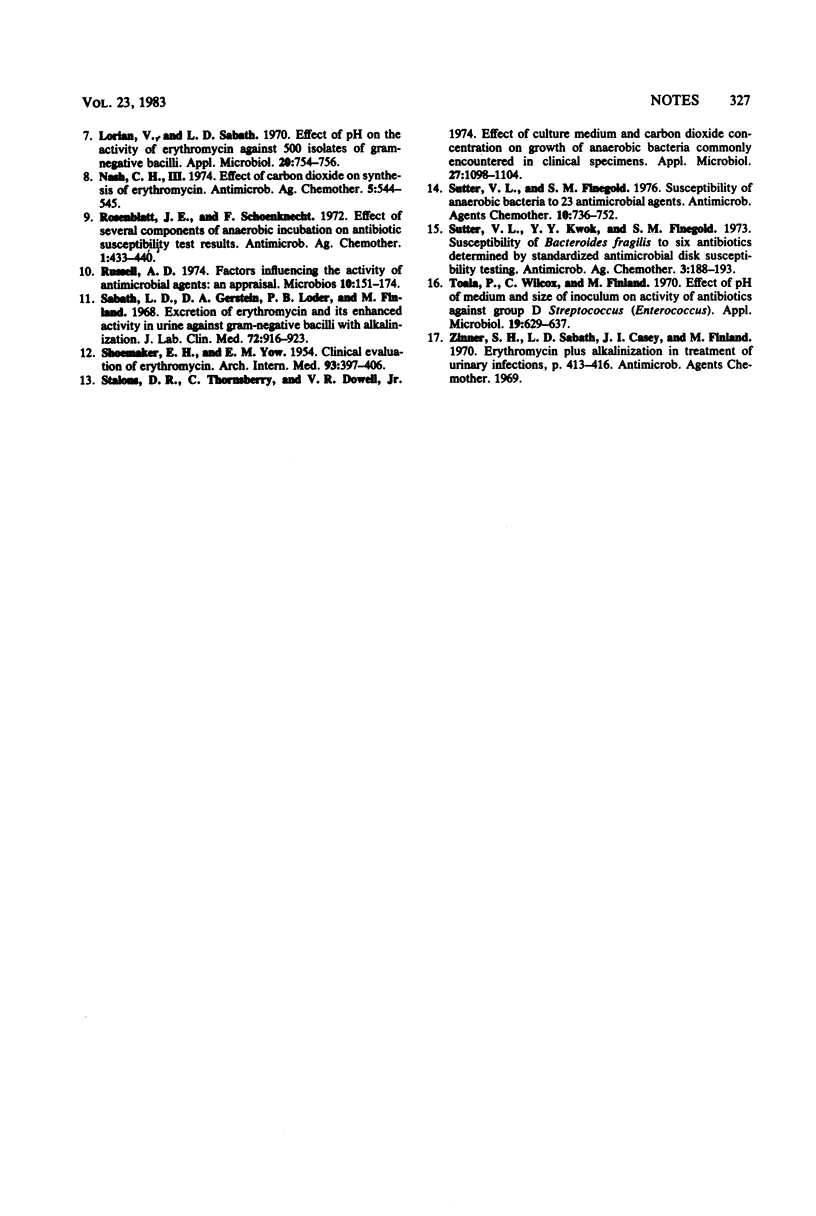Abstract
Exposure of erythromycin solutions to CO2 or air for 18 h resulted in minimal deterioration under both conditions. Saturated disks exposed to the two atmospheres resulted in greater erythromycin deterioration, with slightly more deterioration occurring in the presence of CO2. Reduction of activity was greatest when assays were conducted in a CO2 environment.
Full text
PDF


Selected References
These references are in PubMed. This may not be the complete list of references from this article.
- Appelbaum P. C., Chatterton S. A. Susceptibility of anaerobic bacteria to ten antimicrobial agents. Antimicrob Agents Chemother. 1978 Sep;14(3):371–376. doi: 10.1128/aac.14.3.371. [DOI] [PMC free article] [PubMed] [Google Scholar]
- Goldstein E. J., Sutter V. L., Kwok Y. Y., Lewis R. P., Finegold S. M. Effect of carbon dioxide on in vitro susceptibility of anaerobic bacteria to erythromycin. Antimicrob Agents Chemother. 1981 Dec;20(6):705–708. doi: 10.1128/aac.20.6.705. [DOI] [PMC free article] [PubMed] [Google Scholar]
- Ingham H. R., Selkon J. B., Codd A. A., Hale J. H. The effect of carbon dioxide on the sensitivity of Bacteroides fragilis to certain antibiotics in vitro. J Clin Pathol. 1970 Apr;23(3):254–258. doi: 10.1136/jcp.23.3.254. [DOI] [PMC free article] [PubMed] [Google Scholar]
- Kislak J. W. The susceptibility of Bacteroides fragilis to 24 antibiotics. J Infect Dis. 1972 Mar;125(3):295–299. doi: 10.1093/infdis/125.3.295. [DOI] [PubMed] [Google Scholar]
- Lorian V., Sabath L. D. Effect of pH on the activity of erythromycin against 500 isolates of gram-negative bacilli. Appl Microbiol. 1970 Nov;20(5):754–756. doi: 10.1128/am.20.5.754-756.1970. [DOI] [PMC free article] [PubMed] [Google Scholar]
- Nash C. H., 3rd Effect of carbon dioxide on synthesis of erythromycin. Antimicrob Agents Chemother. 1974 May;5(5):544–545. doi: 10.1128/aac.5.5.544. [DOI] [PMC free article] [PubMed] [Google Scholar]
- Rosenblatt J. E., Schoenknecht F. Effect of several components of anaerobic incubation on antibiotic susceptibility test results. Antimicrob Agents Chemother. 1972 May;1(5):433–440. doi: 10.1128/aac.1.5.433. [DOI] [PMC free article] [PubMed] [Google Scholar]
- Sabath L. D., Gerstein D. A., Loder P. B., Finland M. Excretion of erythromycin and its enhanced activity in urine against gram-negative bacilli with alkalinization. J Lab Clin Med. 1968 Dec;72(6):916–923. [PubMed] [Google Scholar]
- Sutter V. L., Finegold S. M. Susceptibility of anaerobic bacteria to 23 antimicrobial agents. Antimicrob Agents Chemother. 1976 Oct;10(4):736–752. doi: 10.1128/aac.10.4.736. [DOI] [PMC free article] [PubMed] [Google Scholar]
- Sutter V. L., Kwok Y., Finegold S. M. Susceptibility of Bacteroides fragilis to six antibiotics determined by standardized antimicrobial disc susceptibility testing. Antimicrob Agents Chemother. 1973 Feb;3(2):188–193. doi: 10.1128/aac.3.2.188. [DOI] [PMC free article] [PubMed] [Google Scholar]
- Toala P., Wilcox C., Finland M. Effect of pH of medium and size of inoculum on activity of antibiotics against group D Streptococcus (Enterococcus). Appl Microbiol. 1970 Apr;19(4):629–637. doi: 10.1128/am.19.4.629-637.1970. [DOI] [PMC free article] [PubMed] [Google Scholar]


